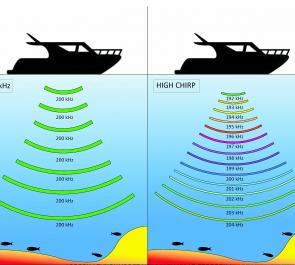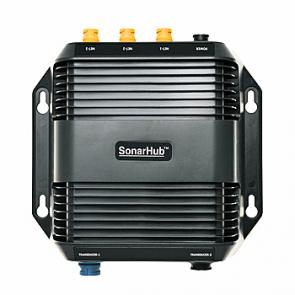So if you have been looking at or reading about sounders in the past year or so, there is no doubt you may have come across the word Chirp.
It’s been a bit of a buzzword lately and is becoming a mainstay feature in the marine electronics world. Initially only available expensive top end sounders and often needing a big add on box, Chirp is now readily available and built into affordable, entry-level units.
It’s really quite simple. A normal transducer (the part that connects to your sounder and goes into the water) will send out waves in the water at a certain frequency, commonly these are 83kHz, 50kHz and 200kHz, depending on your sounder and the transducer you have. These waves are sent into the water and then bounce back to the transducer, which is then translated as the image on our sounder screen.
Chirp works slightly different, it too sends out waves into the water, but instead of it being at just one set frequency it sends the waves out in various frequencies at the one time. Again, depending on the transducer you have, you will have different options, but generally chirp will give you the option of ‘High’, ‘Medium’ and ‘Low’.
In Lowrance sounders, High Chirp will send out frequency waves between 160-240kHz, Medium will send waves out at 60-100kHz and Low will send out waves at 40-60kHz.
As a general rule of thumb, High Chirp is suited to shallower water that you would find in most estuaries, rivers, lakes and dams. It’s range is useful to about to about 70-80m.
In water around 100m, Medium Chirp is a better option and then in deeper water (150m+), Low Chirp is the best to use. Of course this a very general rule and it will vary with which transducer and settings you are using.
Now you know how it works, what are the benefits of this technology? Thanks to the multiple frequencies being sent out, we are able to receive more information and in turn produce a better sonar image.
With Chirp you will instantly find that there is a reduction of clutter through the screen. The screen will appear much clearer. This is a big help when moving at high speeds.
Another benefit with Chirp and in my opinion the most important is its target separation. This is, its ability to distinguish objects that are close together and not just show them as one big cloud of colour. With standard sonar set on a single frequency, if we go over a piece of structure that has fish holding tight in close to it, it can be hard to tell if the fish are actually there. Chirp will help in this situation by giving us better definition, which will help show us pick out what’s really down there.
Another cool feature with Chirp is its crisp fish arches. Arches come out clean and clear and extremely easy to see. The multiple frequencies of Chirp really make things easy for anglers.
As mentioned earlier, Chirp is becoming more and more available in entry level units. There was a time when Chirp was considered a top end feature and was very expensive. But as technology advances we are starting to see it move through the sounder ranges. The Lowrance Elite range offers Chirp in its sounders in 4, 5, 7 and 9” models. Chirp is also available as an add on ‘plug and play’ feature for Lowrance HDS Gen 2 through the Sonar Hub module. I have been using this for the past couple of months with my HDS Touch units.
Depending on your budget and what sort of set up you require there are plenty of options that can get you with a Chirp capable sounder.
Transducers are an important part of getting great results from Chirp. In the Lowrance range, Chirp will work with the generic transducers that are supplied, (83/200kHz, 50/200kHz and HDI Transducer) and this is what I have been using on my setup. This will give a good quality Chirp image without breaking the bank.
If you want to step it up and move onto something that will make the most of your Chirp sounder, there are aftermarket specific Chirp transducers available. Some of these will allow you to select the exact frequency range you would like to cover, this lets you fine-tune things exactly how you want and can give you outstanding results. Have a look at the Airmar TM-150 Transducer, this is Chirp dedicated and from all reports produces some great readings.
Some Chirp transducers can also offer a higher power output (600w and 1kw), which can help penetrate the depths in deep water.
Chirp sounders are here to stay and with good reason. Over the past couple of years I have mainly stuck with my favoured structure scan for my fish finding. But since using the Sonar Hub module and adding Chirp to my sounder I have found myself using it more and more to pick up on the finer details. It’s a valuable tool to have at your disposal as anglers!
For more information on Chirp check out the Lowrance website, there are a few videos that provide some more insight into how the sounders work, well worth a look.
Reads: 11703
This diagram is an example of how Chirp sound waves work compared to traditional sonar.

This screen shot shows Chirp (Top Left) used alongside Structure Scan. Chirp shows some clear fish arches on the drop off.

Lee Parkhouse saved this image. This was taken with a dedicated Chirp Transducer and Sonar Hub.

Sonar Hub serves as a Chirp add on for Lowrance HDS Gen2 models. Most recently, Lowrance HDS Gen3 have been released and come built in with Chirp.




